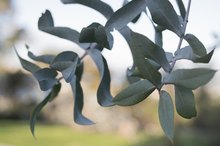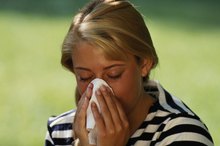Allergies to Sagebrush
Allergies to sagebrush, which grows in western North America, compare equally with more well-known ragweed allergies, which occur largely in Eastern areas of the continent. Both plants reside in the Artemisia genus, along with related plants such as mugworts. Patients who have sagebrush allergies might have similar pollen allergy triggers in the same genus or Compositae family. Sensitivity to allergenic proteins shared by these plants produces hay fever symptoms when patients inhale airborne pollen during the reproductive season.
If you are experiencing serious medical symptoms, seek emergency treatment immediately.
Function
Allergy symptoms will arise during late summer or early fall when sagebrush plants send their pollen grains into the air for distribution. Sensitive individuals develop pollen allergy symptoms, or seasonal allergic rhinitis, when they ingest a threshold level of sagebrush allergens. As the University of Maryland Medical Center reports, the allergic release of antibodies and histamines into the blood creates the same inflammatory health effects that accompany all types of hay fever 1.
- Allergy symptoms will arise during late summer or early fall when sagebrush plants send their pollen grains into the air for distribution.
- Sensitive individuals develop pollen allergy symptoms, or seasonal allergic rhinitis, when they ingest a threshold level of sagebrush allergens.
Features
What Are the Allergy Symptoms to Eucalyptus Pollen?
Learn More
Pollen allergy symptoms include:
- itching in the eyes
- ears
- mouth
- throat
- face
- the UM Medical Center notes
These signs of inflammation can progress to include swelling and an accumulation of fluid in some of those areas. People with sagebrush allergies suffer from runny noses, sneezing, postnasal drip and sinus congestion on days with high pollen counts. An inflamed throat can also become sore and prompt painful coughing.
Effects
Hay fever attacks last as long as patients remain in environments that contain certain levels of reproductive sagebrush pollen. For this reason, allergists at the Asthma and Allergy Foundation of America recommend a change of venue during ragweed or sagebrush season for patients who get severe symptoms 23. The effects of sagebrush allergies can also be mitigated by staying indoors with filtered air conditioning controlling the air quality.
- Hay fever attacks last as long as patients remain in environments that contain certain levels of reproductive sagebrush pollen.
- The effects of sagebrush allergies can also be mitigated by staying indoors with filtered air conditioning controlling the air quality.
Prevention
Common Allergies in August & September
Learn More
Patients can reduce health symptoms with medications such as antihistamines, decongestants and nasal steroids. However, preventing exposure to sagebrush pollen does the most good, the UM Medical Center reports. During pollen season, the AAFA advises patients to limit going outside before 10 a.m. because airborne pollens proliferate in the early morning. Showering and changing clothes after being outdoors discourages indoor pollen accumulation and inhalation. Allergy shots can also provide ongoing preventive protection for some individuals.
- Patients can reduce health symptoms with medications such as antihistamines, decongestants and nasal steroids.
- During pollen season, the AAFA advises patients to limit going outside before 10 a.m. because airborne pollens proliferate in the early morning.
Misconceptions
A pollen allergy to sagebrush differs from a reaction to sage, or salvia, the herb. The latter plants represent the mint family, or Lamiaceae, and do not have cross-reactive properties with sagebrush. Patients with sagebrush allergies can, however, develop hay fever symptoms from eating foods such as sunflower seeds from the Compositae family, according to the AAFA.
- A pollen allergy to sagebrush differs from a reaction to sage, or salvia, the herb.
- Patients with sagebrush allergies can, however, develop hay fever symptoms from eating foods such as sunflower seeds from the Compositae family, according to the AAFA.
Related Articles
References
- University of Maryland Medical Center: Allergic Rhinitis
- Asthma and Allergy Foundation of America: Ragweed
- Asthma and Allergy Foundation of America: Pollen and Mold Counts
- Asthma and Allergy Foundation of America. Pollen Allergies.
- Dellavalle CT, Triche EW, Leaderer BP, Bell ML. Effects of ambient pollen concentrations on frequency and severity of asthma symptoms among asthmatic children. Epidemiology. 2012;23(1):55-63. doi:10.1097/EDE.0b013e31823b66b8
- Handa S, De D, Mahajan R. Airborne contact dermatitis - current perspectives in etiopathogenesis and management. Indian J Dermatol. 2011;56(6):700-6. doi:10.4103/0019-5154.91832
- Texas MedClinic. Symptoms and Remedies for Cedar Fever.
- Portelli MA, Hodge E, Sayers I. Genetic risk factors for the development of allergic disease identified by genome-wide association. Clin Exp Allergy. 2015;45(1):21-31. doi:10.1111/cea.12327
- The American Academy of Allergy, Asthma & Immunology. SLIT Treatment for Allergic Rhinitis Nothing to Sneeze About.
- Oral allergy syndrome (OAS). The American Academy of Allergy, Asthma & Immunology.
- Gao Z, Huang M, Qu Z, Wang J, Cai X.Identification of DNA methylation module in seasonal allergic rhinitis.Int J Pediatr Otorhinolaryngol. 2019 Feb;117:163-166. doi: 10.1016/j.ijporl.2018.11.030. Epub 2018 Nov 29.
- Maya-Manzano JM, Sadyś M, Tormo-Molina R, Fernández-Rodríguez S, Oteros J, Silva-Palacios I, Gonzalo-Garijo A.Relationships between airborne pollen grains, wind direction and land cover using GIS and circular statistics.Sci Total Environ. 2017 Apr 15;584-585:603-613. doi: 10.1016/j.scitotenv.2017.01.085. Epub 2017 Jan 27.
Writer Bio
Nancy Clarke began writing in 1988 after achieving her Bachelor of Arts in English and has edited books on medicine, diet, senior care and other health topics. Her related affiliations include work for the American Medical Association and Oregon Health Plan.









